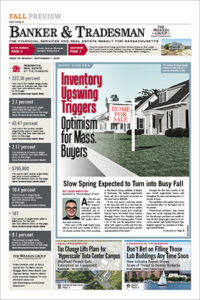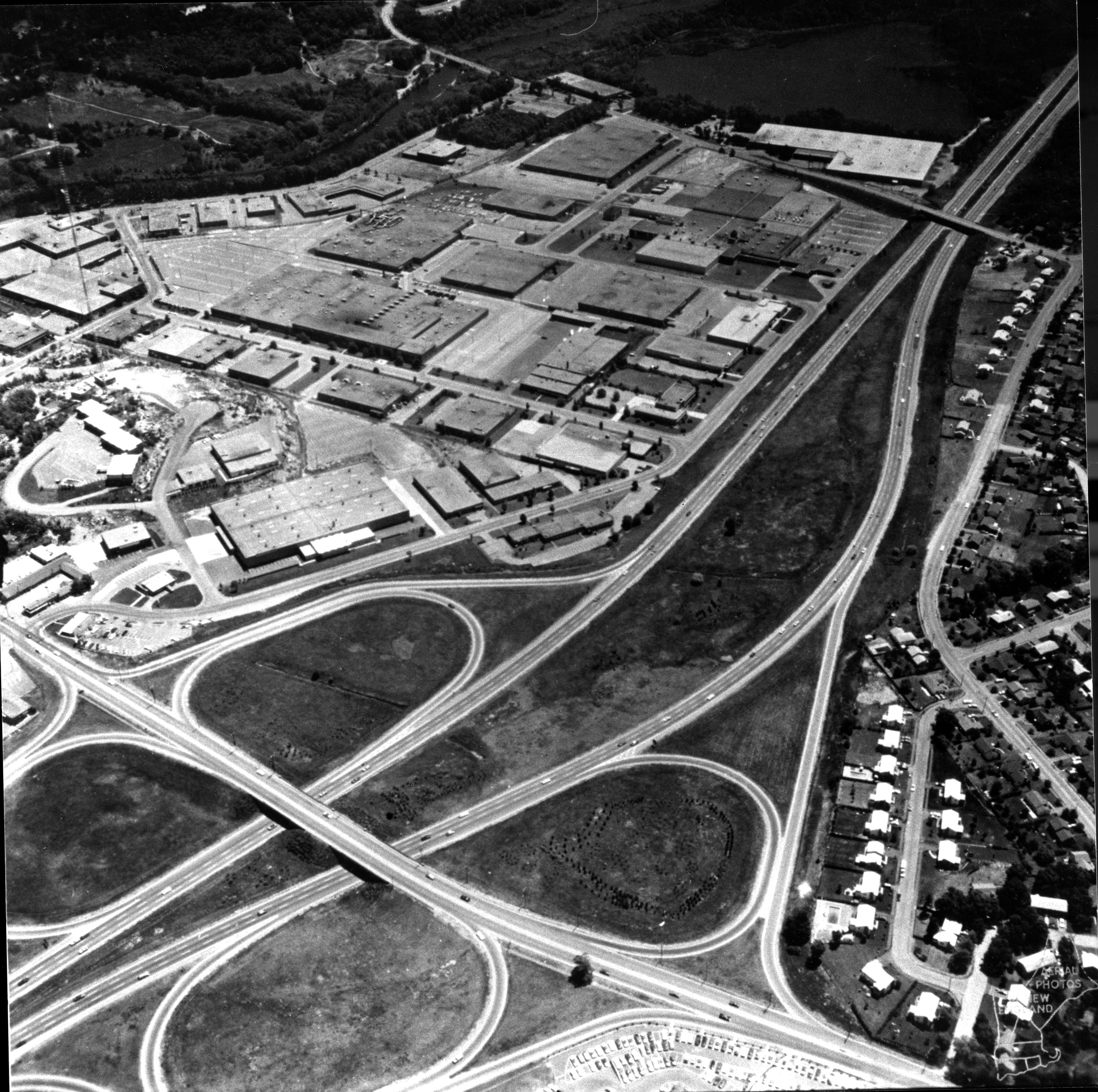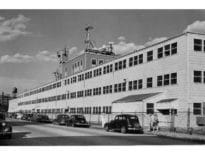
The cover of Banker & Tradesman’s Feb. 20, 1901 issue, later put into a time capsule in the Old State House that was unearthed in 2015. The paper, at that time, largely consisted of real estate records, advertisements for a wide range of products and services and a periodic investment advice column from editor George T. Lincoln. The Warren Group image
When the federal courthouse opened in 1998 on Fan Pier, not far from the Summer Street building where Banker & Tradesman had its office at the time, the newspaper’s editor had questions.
“At that time, it was the only thing in that area – the federal courthouse, parking lots and The Barking Crab,” said Michelle Deakin, Banker & Tradesman’s editor from 1997-2000. “How was that area going to be developed? Was it going to be developed? If things were built there, would anybody go?”
Banker & Tradesman’s editors have asked these and other questions to shape coverage of the Massachusetts real estate and banking industries.
But this news coverage is relatively new to the 150-year-old newspaper. While weekly news stories, columns, guest articles and editorials have covered topics ranging from the effects of the Great Recession and the pandemic to housing and commercial real estate development, the efforts of a series of editors helped transform the Banker & Tradesman into the paper readers see today.
Simple Beginnings
The paper’s longest-tenured editor, George Glendining, put together weekly editions that looked very different from today’s paper – though some features remain the same.
Launched by George T. Lincoln in 1872, Banker & Tradesman was first published in New York before moving to Boston later that decade. The paper provided a collection of real estate, financial, legal and business information, including the public real estate records still published today.
At a time when these records could only be searched by laboriously combing registries of deeds by hand, Banker & Tradesman centralized the information these records contained in one single source. This gave the paper’s readers a profound advantage over anyone who didn’t buy it.
Another newspaper publisher, Willard C. Warren, had launched similar ventures in Connecticut and later in Worcester. Teaming up in 1901, Lincoln and Warren decided to merge the latter’s Worcester-based newspaper, the Review & Record, with Banker & Tradesman. This deal began the Warren family’s multi-generational ownership of the publication.
Glendining had joined Banker & Tradesman in 1907, becoming editor after Lincoln decided to retire and sell his share of the company to Warren in the early 1920s. Remaining with the newspaper for 60 years, Glendining continued as editor until his death at age 89 in 1968.
In a 1981 memoir, the late Keith Warren, Willard’s son and a member of the second generation of the Warren family to publish Banker & Tradesman, said Glendining was “generally regarded as one of the leading trade paper editors in New England.”
“The B&T was his whole life and even in his 80s he scorned any thought of retirement and came into the office every day by taxi from Newton just to be in the office among the surroundings that he had known for so many years,” Keith Warren wrote in his memoir. “[He] was well known and respected by the entire real estate community of the state.”

Former Banker & Tradesman editors William Mallard and Nena Groskind pose for the camera in this undated photo. Mallard helmed the paper starting in 1968, and hired Groskind in 1977. Photo courtesy of Nena Groskind
A Major Transformation
Following Glendining’s death, Banker & Tradesman’s advertising manager, William Mallard, took over as editor. Along with the late Tim Warren Sr., the third generation of the Warren family to publish Banker & Tradesman, Mallard set out to take the newspaper in a different direction. While readers valued the transaction details they found every week, Mallard, who had joined the paper in 1956, wanted news coverage.
“Bill, who was an old-time newspaper guy, envisioned B&T as a real newspaper,” said Nena Groskind, Banker & Tradesman’s first full-time reporter.
After accepting some freelance and test articles, Mallard hired Groskind in 1977, taking the more than 100-year-old newspaper in a new direction.
Groskind, who later became editor as Mallard focused on running the operations and making the newspaper profitable, said the banking and real estate industries had a mostly positive reaction to the expanded news coverage.
“They liked the attention,” she said. “We tried really hard to do a careful, creditable job to cover the industry in depth, but fairly and accurately.”
Within a few years, Banker & Tradesman would add two reporters – and have significant industry news to cover, including banking deregulation and the failure of savings and loan institutions. While Groskind said she understood the significance of these topics week-by-week, she did not see at the time how historic they would become.
“When I was covering the components of the S&L failures, I knew that was significant, I knew it was a big change, but I don’t think I recognized that it was transformative,” Groskind said. “Banking today looks nothing like it did before the S&L crisis, or before the deregulation process began.”
Mallard retired in 1993 and died in 2002. Groskind, who also had a long-time weekly question-and-answer real estate column that appeared in the Boston Globe, left the newspaper a year after her mentor retired and relocated with her family to Texas.
Timeline: Real Estate and Banking’s March Through Mass. History
 Newspaper Vaults to the Top
Newspaper Vaults to the Top
After Barbara Rabinovitz left her job in 1994 as editor of Massachusetts Lawyers Weekly to become Banker & Tradesman’s next editor, the newspaper saw more changes just six months after she joined the paper.
Along with Tim Warren Jr., a member of the fourth generation of the Warren family to publish Banker & Tradesman and The Warren Group’s current CEO, Rabinovitz helped redesign the paper’s appearance, format and content, as well as the technology used to produce the paper.
The new look, which launched in 1995, included Banker & Tradesman’s first editorial and opinion page, as well as a weekly editorial cartoon.
The paper’s redesign merited a write-up in the Boston Globe, and the National Association of Real Estate Editors named Banker & Tradesman the second-best real estate publication with fewer than 200,000 readers in 1996.
A few months after she left the paper in 1997 to become managing editor of The Jewish Advocate, Rabinovitz wrote a column for Banker & Tradesman’s 125th anniversary edition where she reflected on the opportunity to work with Tim Warren Jr., the newspaper’s reporters and production staff.
“For while I greatly enjoyed presiding as editor of this time-honored institution in Massachusetts and participating in the refashioning of its image and the expansion of its coverage, the company – in the human sense and corporate sense of the word – of which I was a part is what I treasure even more,” Rabinovitz wrote.

Diane McLaughlin
‘A Whole New City’
Michelle Deakin followed her former Massachusetts Lawyers Weekly colleague to Banker & Tradesman to become the next editor in 1997. Two years later, NAREE named Banker & Tradesman as the best real estate publication with fewer than 200,000 readers.
Along with the opening of the John Joseph Moakley U.S. Courthouse, other key topics the paper covered during Deakin’s tenure include the the residential real estate boom, the effects of large bank mergers and the impact the high-technology industry had on shaping the Route 128 and Interstate 495 real estate markets.
Deakin and her staff also covered stories that looked as if they would have significant effects on the state but went nowhere: the New England Patriots’ plan to relocate to Hartford and the Boston Red Sox’s proposal to build a new Fenway Park.
And even as she shaped Banker & Tradesman’s coverage of Seaport District’s development, she never anticipated what it has become today.
“I could never at the time have imagined that a whole new city would grow there the way that it has,” Deakin said. “It’s really an amazing transformation.”






